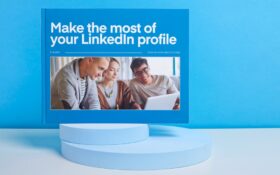
Should the content of your resume be the same as your LinkedIn profile? Many job seekers even wonder why they need both a resume and a LinkedIn profile in the first place. Don’t they both say the same thing?
The answer is no; each is unique. Your resume and LinkedIn profile are separate tools each with its own purpose. In this article I’ll tell you how to differentiate your resume from your LinkedIn profile.
Disclosure: We are affiliates for some of the products and services mentioned on this page. Learn more
What is the purpose of a resume?
A resume is a targeted message that aims to meet the specific needs of a prospective employer. A resume provides select information that an employer needs to know. It does this using examples from your career history. Consider it a snapshot of only the best and most relevant content.
What is the purpose of a LinkedIn profile?
A LinkedIn profile is different to a resume. A LinkedIn profile is an overarching story of your career path. A well optimized LinkedIn profile highlights your key strengths and accomplishments. It should speak to a broader audience and communicate your personal brand.
Resumes and LinkedIn profiles work together
Together, a resume and LinkedIn create a robust overview of what you’ve achieved. They tell the story of how you got to where you are today, the value you currently provide, and where you want to go.
Your resume and LinkedIn profile should compliment but not repeat each other.
The aim is to make your LinkedIn profile and resume align. LinkedIn provides the big picture narrative whilst a resume provides the details tailored towards the reader.
Aligning your resume and LinkedIn profiles to complement each other offers more value to your readers.
What should be the same on your resume and LinkedIn profile?
It’s essential that the story lines up. A reader should not encounter discrepancies on dates, titles, or education. This would raise red flags.
Providing consistent information around the finer details reduces confusion and mixed messaging. The positioning of your personal brand and professional experiences should also be consistent.
Let’s explore each section in detail.
Name and title
Use your ‘everyday’ name on both your resume and LinkedIn profile. If you are a Richard who goes by Rick, use Rick. If you are a Mary Lynn who goes by Lynn, use Lynn.
Consistency is important across all communications. This makes it easy for employers to locate and connect your materials and information.
If you title yourself as an Executive CHRO on your resume use the same title on LinkedIn. Although it’s a good idea to expand the details on your LinkedIn headline and use up the full 220 characters.
You should also create a custom LinkedIn URL with this same name. Learn how to do this in the video below.
Company names, position titles, & dates
Over time, some organizations change names and position titles. A Customer Account Manager might become a Client Success Manager. Check to make sure all titles and dates match on both the resume and LinkedIn.
Education institutions and dates
To avoid agism you might want to forego listing the dates of your education on your resume.
LinkedIn also allows you to exclude dates as well. Consider why you might list dates in one place and not another – can it be consistent?
These are the sections of your resume and LinkedIn profile that should always match. Now let’s look at the sections where the content may vary between the two mediums.
What should be different between your resume and LinkedIn profile?
Add extra value to your LinkedIn profile by filling in details or gaps that might not be on a targeted resume.
Your resume should speak to specific accomplishments and experiences that address the employer’s needs. Your LinkedIn profile is your opportunity to expand the story.
Resume summary & LinkedIn About section
Keep the professional summary on your resume to 3 or 4 sentences. Use this section to connect your value to the target job. Be concise and specific.
On LinkedIn, expand your About section into a more robust overview. This section offers you 2,600 characters to write your professional story in a less formal voice.
The About section is a brand-building section. Infuses it with your personality and make sure you write it in the first person.
Position descriptions
Your resume should showcase the details of your past roles that are most relevant to your target role.
You can use your LinkedIn profile to show more stories of how it all came to be. Include extra facts on your LinkedIn profile that are more generic.
Keywords
Your LinkedIn and resume will likely share many of the same keywords. But only your resume is customizable for each unique job application.
Read each job posting and select keywords that match job requirements. These are the words that should be on your resume.
Use a tool like Jobscan to help you do this. Jobscan will scan your resume and tell you which keywords to include. You can discover more about Jobscan, here.
On LinkedIn you are writing for a broader audience. But remember that LinkedIn is also agiant database.
It’s essential to include keywords to help you get found. Populate your profile with keywords and use all allowed 50 Skills in the LinkedIn Skills section.
Again, Jobscan is a great tool for helping you to identify and include the right keywords on LinkedIn.
Awards, certifications & volunteering
Keeping your resume focused may mean no room for awards, certifications, and volunteer experiences.
Include these details on your LinkedIn to highlight commitment to professional development and community.
Specific facts & metrics
Consider which facts may be ‘safer’ to share on a resume versus a public platform like LinkedIn. In a resume, specific metrics (budget amounts, dollars saved, revenue figures, profit and loss measurements) can increase the value of your content and provide proof of ability. In fact, your resume should be as results focused as possible.
You may not want to share these same details on LinkedIn. An option is it ‘soften’ details on LinkedIn. Instead of listing the exact budget size ($2M), you can say “multimillion-dollar budget”. Or, instead of listing specific sales growth ($1.3M to $2.4M in 2 years) try “increased sales 85% in 2 years”.
Conclusion
Employers are hungry for details. When they shift between a resume and LinkedIn profile, they appreciate extra value-rich details to support their decision.
Simply copying and pasting career details between the resume and LinkedIn profile is an opportunity wasted.
Spend time differentiating your LinkedIn profile from your resume. Aim to create a suite of tools that compliment rather than replicate each other.




